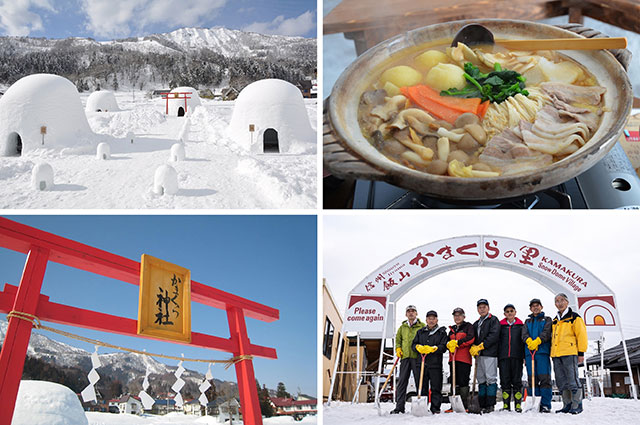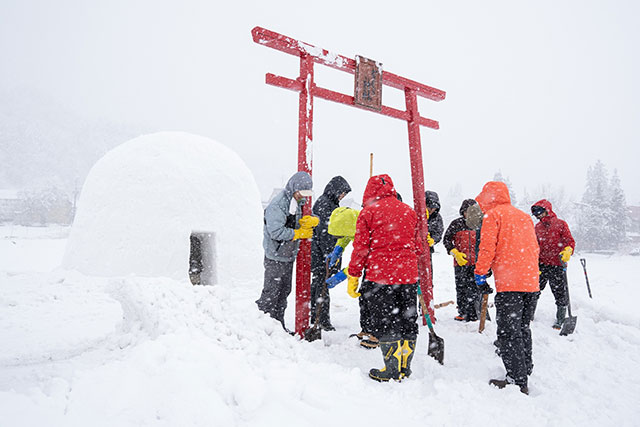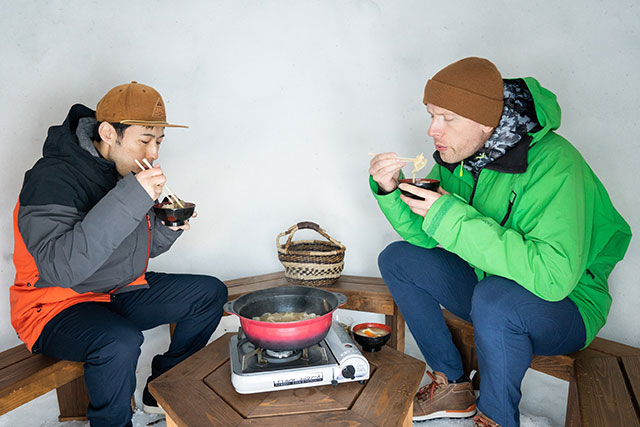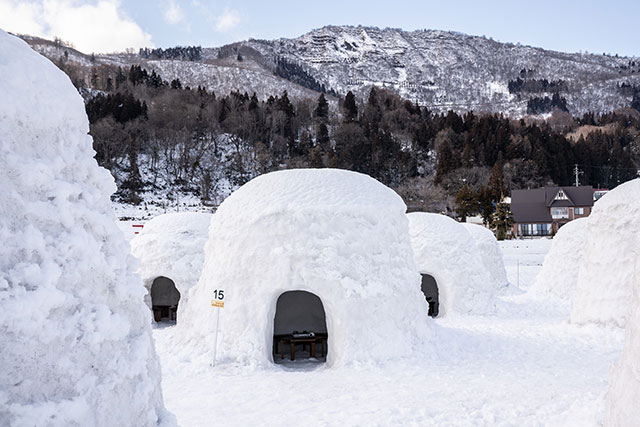
When winter reaches its peak, and the area is caked in a thick layer of fresh snow, the town of Iiyama in the north of Nagano offers an unusual and fun way to spend an evening (or lunchtime) dining. Every year from January, over twenty igloo-like snow-houses, known as kamakura in Japanese, are erected, and steaming bowls of nabe (Japanese hot pot) are served up inside.
-
![Kamakura-no-Sato in Iiyama]()
Kamakura-no-Sato in Iiyama
![Twenty-five kamakura snow-houses are made for visitors to enjoy]()
Twenty-five kamakura snow-houses are made for visitors to enjoy
![Dinner is served! Japanese hot pot cooking inside one of the kamakura]()
Dinner is served! Japanese hot pot cooking inside one of the kamakura
-
![Gather round one and all!]()
Gather round one and all!
-
03
Welcome to Kamakura-no-Sato!
Kamakura-no-Sato, or Snow Dome Village, as it is sometimes referred to in English is a community lead initiative that comes to life every winter thanks to the hard work and dedication of a few passionate locals. They spend weeks preparing and creating a collection of kamakura snow-houses on the outskirts of town (roughly 7 km from Iiyama Station) for locals and tourists to enjoy. Inside the kamakura you’ll find wooden chairs positioned around tables, upon which is a small gas stove for cooking your nabe (Japanese hot pot)! Drinks are also served, although you are also free to bring your own, making for the perfect atmosphere to enjoy your hearty meal.
![Kamakura-no-sato]()
Kamakura-no-sato
![A steaming bowl of nabe made with fresh, local ingredients only]()
A steaming bowl of nabe made with fresh, local ingredients only
![The onigiri riceballs are also made with 100% local rice]()
The onigiri riceballs are also made with 100% local rice
-
04
What is nabe?
Nabe is a common dish served in Japan during the colder months, essentially it is a hot stew that is cooked at the table using a portable stove. Ingredients are typically made up of vegetables like onion, cabbage, mushrooms and carrots, with meats like beef and/or pork, in a lightly flavored stock.
The nabe served at Kamakura-no-Sato consists of vegetables and meat from local Iiyama farms - all ingredients are local, seasonal and fresh. The chef at Kamakura-no-Sato has been based in Iiyama for years, and is well known among the local community. He also makes homemade sake (Japanese rice wine) using rice from the local paddies, which can be ordered at Kamakura-no-Sato too.![Nabe – A Japanese hot pot]()
Nabe – A Japanese hot pot
-
05
How it all began
The idea for Kamakura-no-Sato started in 2001 after local ski resort, Shinanodaira, decided to close its doors to the public due to a decline in visitors. In an attempt to keep tourists interested in the town though, a small group of local volunteers, headed by a local named Mr. Miyazawa, got together and brainstormed ways of keeping Iiyama a fun place to visit. They decided to take things in a completely new direction, by teaming up with a local chef and offering a unique place to eat locally produced nabe, while enjoying the snow. And so, Kamakura-no-Sato was born.
During the first few years the group of volunteers involved, consisted of only five members, making a total of ten kamakura snow-houses per year. But as time went on the group of volunteers grew, as did the number of kamakura. The team is now twenty strong, with the amount of kamakura being built each year reaching over twenty-five! Mr. Miyazawa is still group leader and still very much running the project despite being over eighty years of age.![Some of the volunteers involved in making Kamakura no Sato each year]()
Some of the volunteers involved in making Kamakura no Sato each year
![Mr. Miyazawa explaining the process of making kamakura]()
Mr. Miyazawa explaining the process of making kamakura
The volunteers are all locals, most of them retired. They come from a variety of backgrounds, although the majority of them were farmers. Some worked at the ski resort before it was closed down, others worked for local authorities. What they all have in common is that they are Iiyama born and bred, and are very passionate about promoting the town as somewhere fun for tourists to visit.
![One single kamakura takes the manpower of 5-6 people, all with individual roles and jobs]()
One single kamakura takes the manpower of 5-6 people, all with individual roles and jobs
-
![The initial shape of the kamakura is obtained by inflating a large rubber balloon, which is then covered in clumps of snow, that are then patted into shape by the volunteers using their hands and spades. The shape of the kamakura is then maintained on a daily basis]()
The initial shape of the kamakura is obtained by inflating a large rubber balloon, which is then covered in clumps of snow, that are then patted into shape by the volunteers using their hands and spades. The shape of the kamakura is then maintained on a daily basis
At the far end of the snow dome village there is also a small shrine, which is of course inside a kamakura, also made by the volunteers. It is believed in Shintoism, Japan’s only native religion, that Shinto gods reside everywhere and in almost everything naturally created - and this shrine is to pay respect to the god of the mountains that surround Iiyama, and to offer gratitude for the years snowfall.
![The team at Kamakura-no-Sato erect the “torii” gate having finished making the kamakura shrine]()
The team at Kamakura-no-Sato erect the “torii” gate having finished making the kamakura shrine
![The shrine is remade each and every winter, it has come to represent a symbol of the town and its mountains]()
The shrine is remade each and every winter, it has come to represent a symbol of the town and its mountains
-
![Inside the shrine looks like every other Shinto Shrine in Japan, the “kami” is enshrined inside the wooden honden in the back]()
Inside the shrine looks like every other Shinto Shrine in Japan, the “kami” is enshrined inside the wooden honden in the back
Bookings Kamakura-no-Sato can be made through their English website page direct (see below). They offer three sittings a day for nabe, at 11am, 1pm and 5pm. During the later sitting the kamakura and surrounding area is lit up using candles.
Reservations can be made for sittings of two people minimum, at a cost of 4000 yen person. Sharing of dishes is also an option (two person nabe shared by 3-4 people). Drinks are charged extra, although you are free to bring your own.![The nabe is served in portions for two people or more]()
The nabe is served in portions for two people or more
![Check out Kamakura-no-Sato for yourself using their website for reservations!]()
Check out Kamakura-no-Sato for yourself using their website for reservations!
- Kotobuki Mura
-
-
- Nagano Iiyama-shi Kotobuki 807-2
-
-
-
- 0269625234
-
-
-
- https://kamakura-ouendan.net/kamakuraWeb/en/index.php
-
View All


















 Go here
Go here





